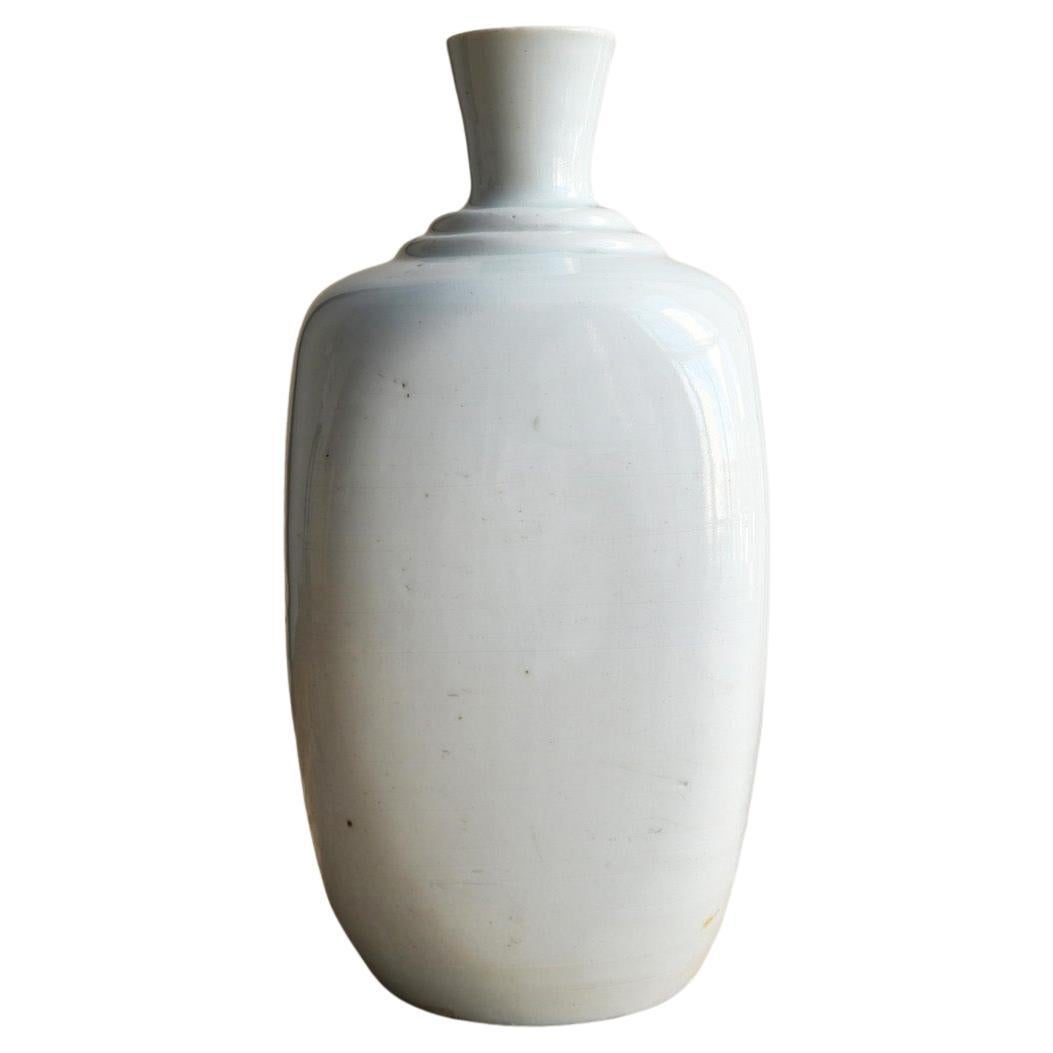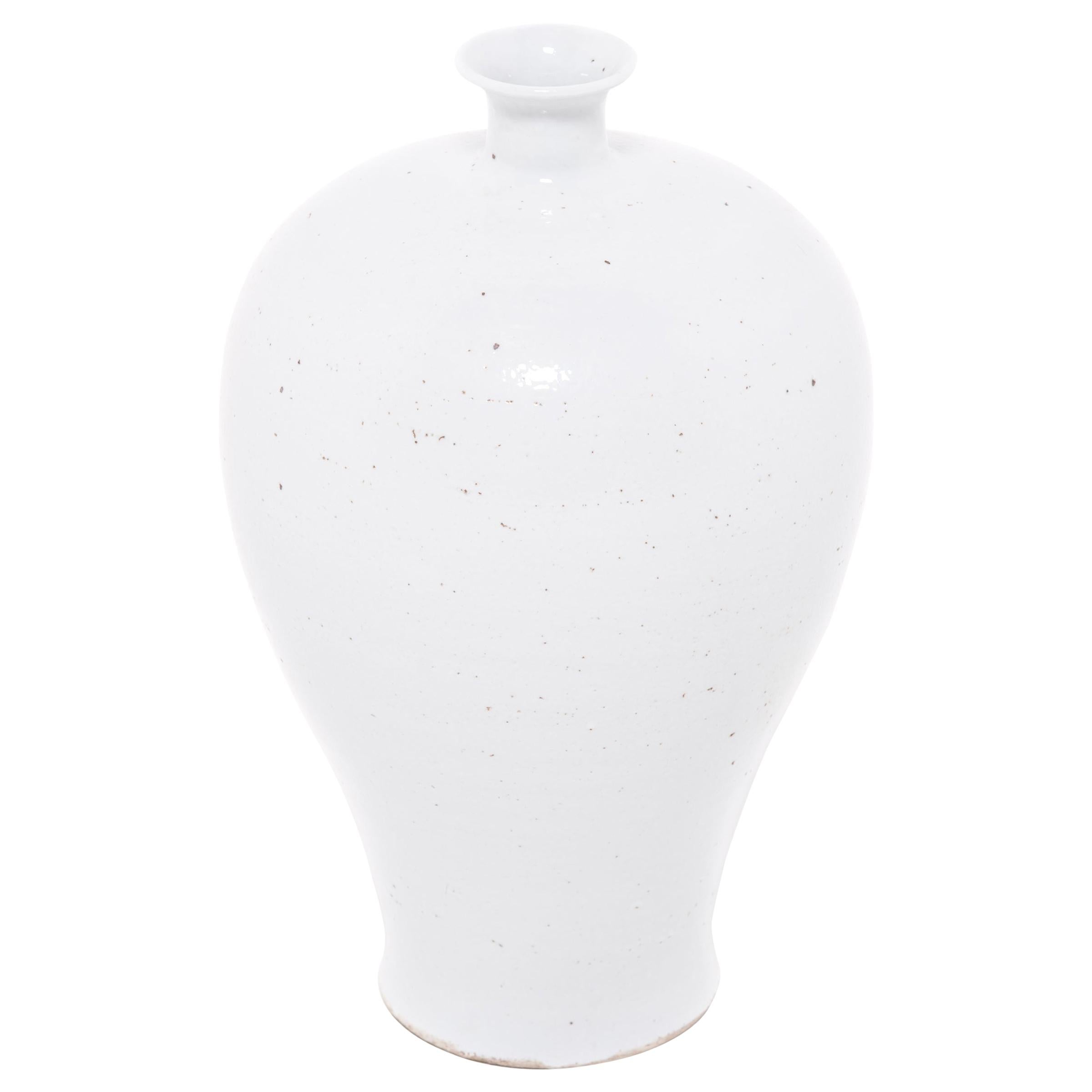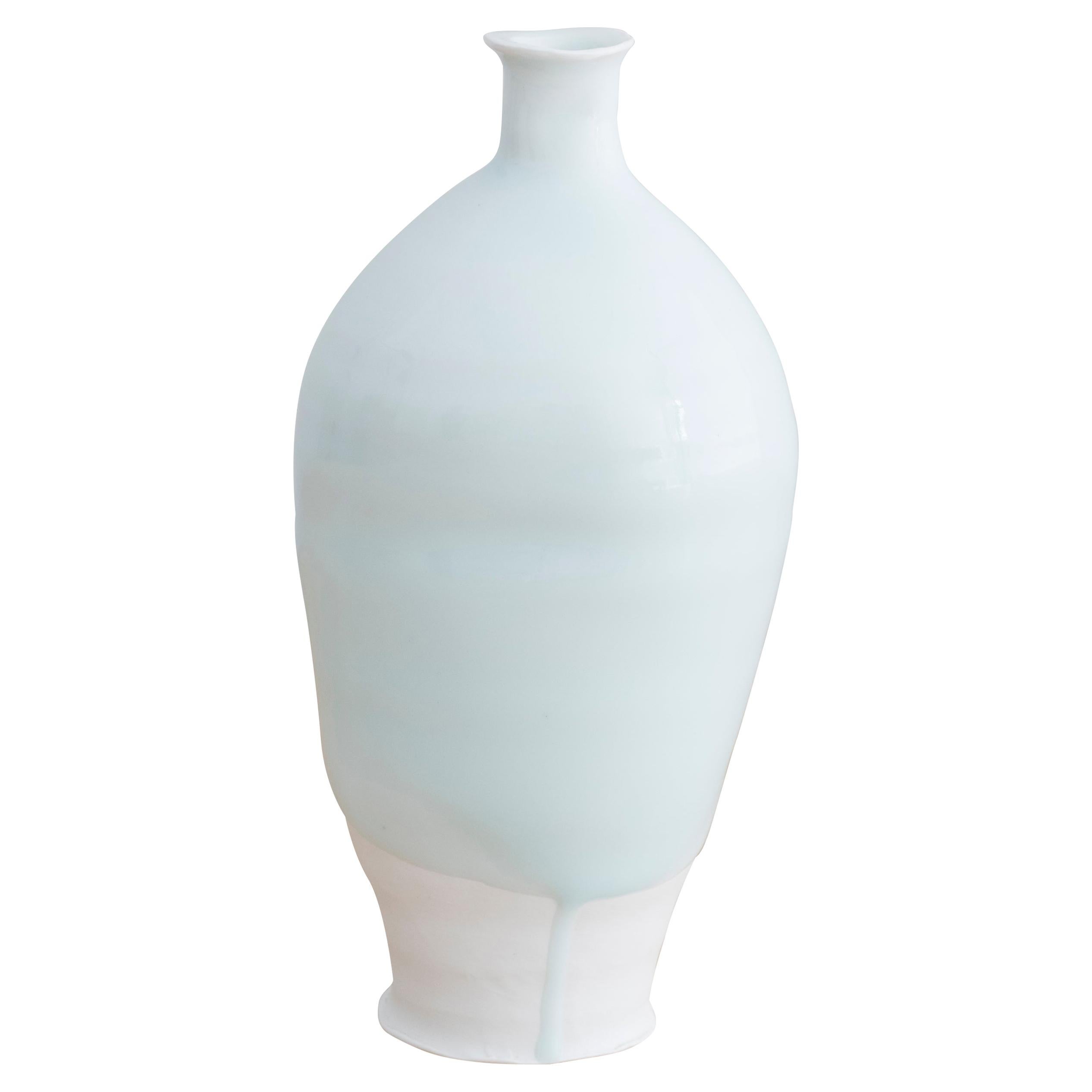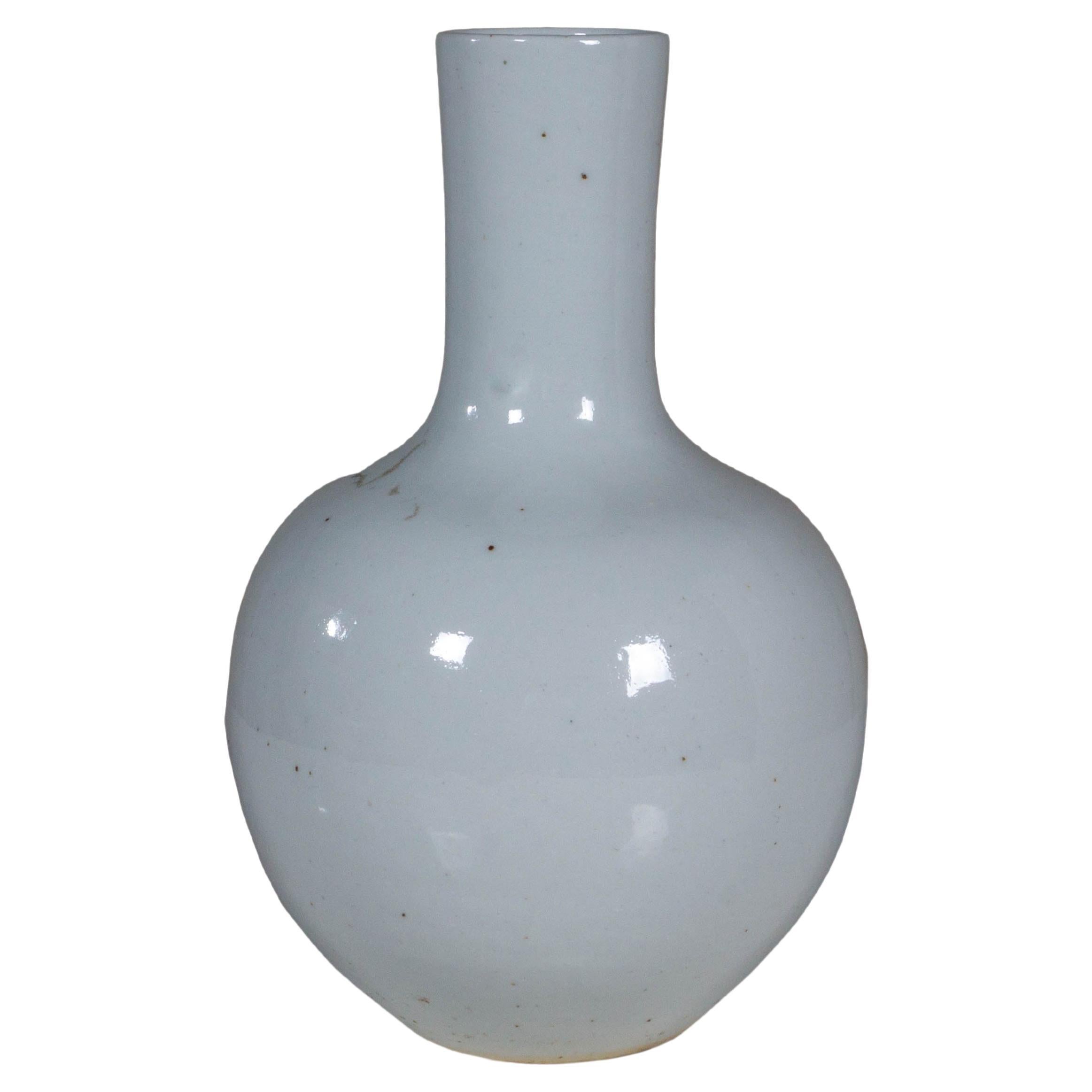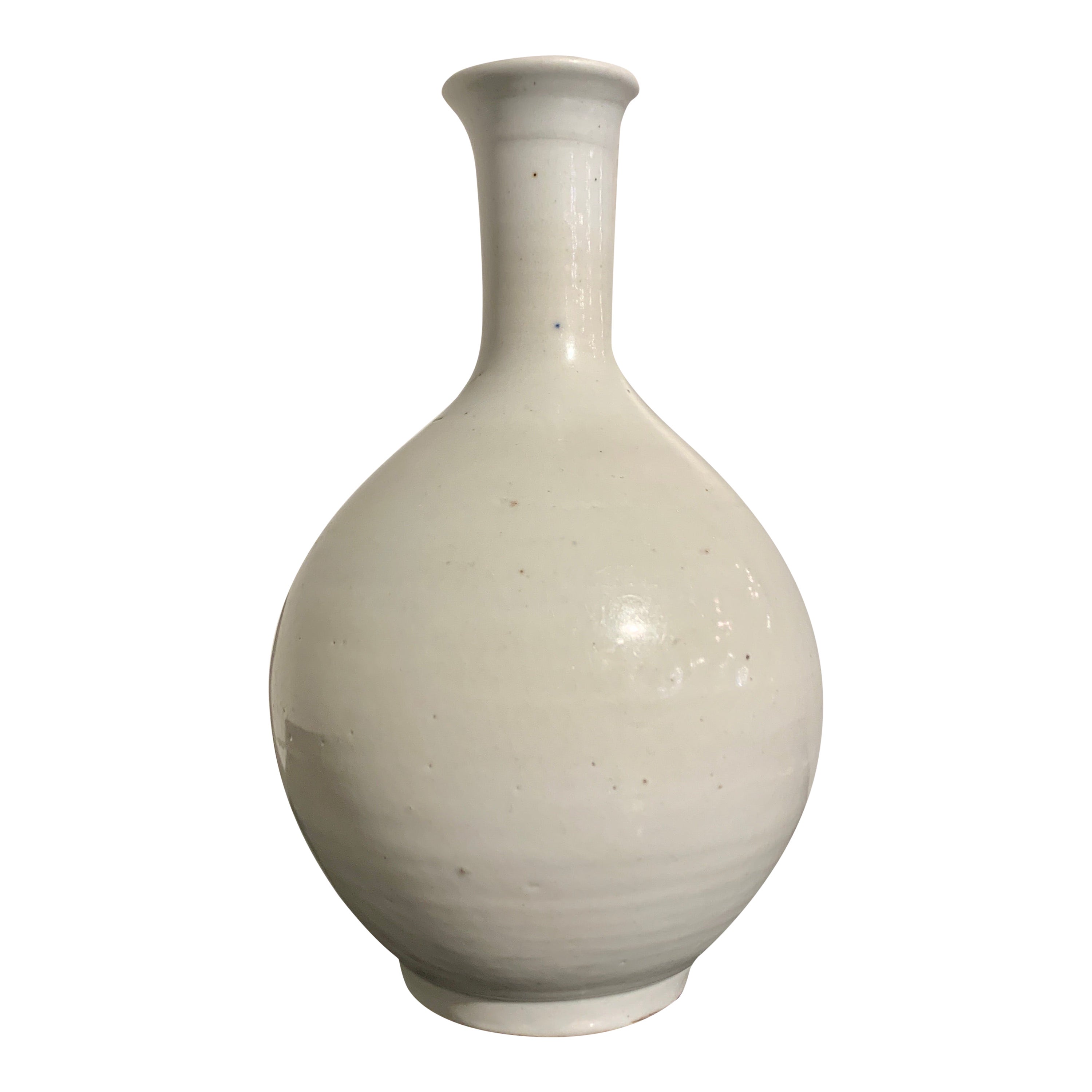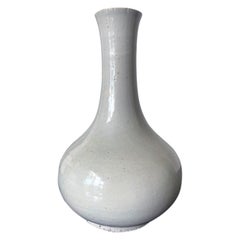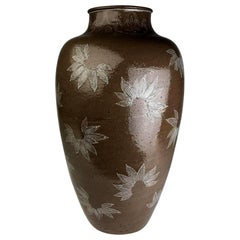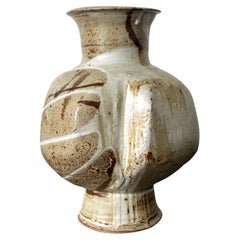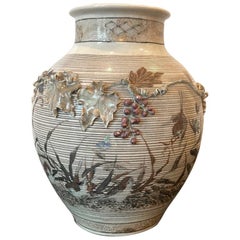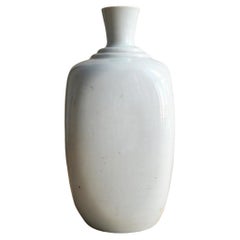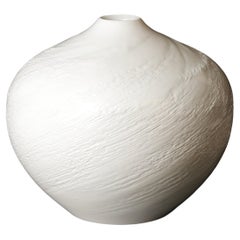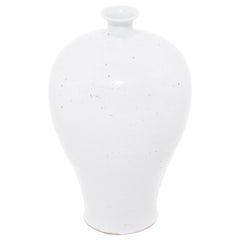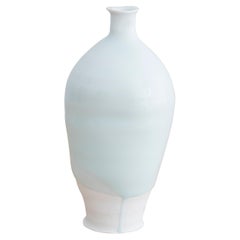Items Similar to Contemporary Japanese White Glaze Ceramic Vase by Manji Inoue
Want more images or videos?
Request additional images or videos from the seller
1 of 12
Contemporary Japanese White Glaze Ceramic Vase by Manji Inoue
$5,200
£3,975.68
€4,579.18
CA$7,286.79
A$8,135.02
CHF 4,262.63
MX$99,580.64
NOK 54,135.42
SEK 51,042.83
DKK 34,174.87
About the Item
A large glazed white porcelain vase in the jar-form by Japanese ceramic artist Inoue Manji (Japanese, b. 1929). Minimalistic in form, the vase is pure white with a very subtle blue hue and of a perfect nearly sphere form. It has a small mouth opening and a short foot ring. It is signed on the base and comes with a titled original wood storage tomobako box as well as a printed note on the artist as shown.
A living national treasure in Japan, Manji was born in 1929. He started his career in Arita ware but
became specialized in white porcelain called Hakuji, using a transparent glaze over white clay (Kaolin) and firing at a high temperature. Inoue demands perfection in shape and is known to be unforgiving, rejecting even a millimeter of distortion. He states that, “Hakuji expresses itself through form rather than added decoration,” and his pieces exemplify this truth through refined curves and purely rounded forms rather than distracting surface decor. Simple lines belie their power as viewers’ eyes are lost in the infinite depth of pure white peaks and valleys. The smooth, soft, silky surface of these delicately hardened forms characterizes the unmatched beauty of Manji’s work.
(From Onishi Gallery).
- Creator:Inoue Manji (Artist)
- Dimensions:Height: 10 in (25.4 cm)Diameter: 12 in (30.48 cm)
- Style:Modern (Of the Period)
- Materials and Techniques:
- Place of Origin:
- Period:
- Date of Manufacture:1990s
- Condition:Wear consistent with age and use. Fine condition. Original Tomobako wear.
- Seller Location:Atlanta, GA
- Reference Number:1stDibs: LU945027354252
About the Seller
4.9
Platinum Seller
Premium sellers with a 4.7+ rating and 24-hour response times
Established in 2006
1stDibs seller since 2010
565 sales on 1stDibs
Typical response time: <1 hour
- ShippingRetrieving quote...Shipping from: Atlanta, GA
- Return Policy
Authenticity Guarantee
In the unlikely event there’s an issue with an item’s authenticity, contact us within 1 year for a full refund. DetailsMoney-Back Guarantee
If your item is not as described, is damaged in transit, or does not arrive, contact us within 7 days for a full refund. Details24-Hour Cancellation
You have a 24-hour grace period in which to reconsider your purchase, with no questions asked.Vetted Professional Sellers
Our world-class sellers must adhere to strict standards for service and quality, maintaining the integrity of our listings.Price-Match Guarantee
If you find that a seller listed the same item for a lower price elsewhere, we’ll match it.Trusted Global Delivery
Our best-in-class carrier network provides specialized shipping options worldwide, including custom delivery.More From This Seller
View AllLarge Antique White Glazed Bottle Vase Korean Ceramic Joseon Dynasty
Located in Atlanta, GA
On offer is a Korean ceramic bottle vase circa 19th century made in the late Joseon dynasty (1392-1910). The vase is of a classic bottle form with a bulbous body and a long neck with...
Category
Antique 19th Century Korean Other Ceramics
Materials
Ceramic
Rare Large Vase with White Slip Inlay Makuzu Kozan Meiji Period
By Makuzu Kozan
Located in Atlanta, GA
A impressively large and unusual stoneware vase in an urn shape from the studio of Japanese Potter Makuzu Kozan, also known as Miyagawa Kozan (1842–1916), one of the most established and collected ceramist from Meiji Period. Born as Miyagawa Toranosuke, Kozan established his pottery studio in Yokohama circa 1870s and later became one of the appointed artist to the Japanese Imperial household. His work was exhibited in many international fairs that the Meiji government participated at the turn of the century and won many grand prizes.
This vase is dated to the end of Makuzu's life circa 1910-1916 based on similar work created around that time. After achieving domestic and international fame, Makuzu retired and handed the business to his son Hanzan in 1912. He dedicated his time to other selected projects that were more in tune with Japanese sensibility than export aesthetic. He made a group of stoneware pottery pieces inspired by Edo master like Ninsei and Kenzan as well as his own poetic creation. This piece is attributed to that period.
Standing of an impressive size, this vase is more like an urn, made with stoneware instead of porcelain. It was coated with a brown iron glaze with a slight translucent quality. Underglaze whit slips were used to draw low relief decoration of bamboo leaves that sparsely scatter on the surface. Slightly more elaborate scrolling vines and autumn flowers circles under the mouth rim. Same white slip inlay was used to sign the vase under the base. The whole effect of the piece is unusual. With its dark glaze in contrast with the sparse white decoration that is more abstract and geometric than realistic, it appears almost modern with an Art Deco flavor.
For stoneware urn and vase in the similar genre by Makuzu Kozan: see figure 113 on page 182 of "Sekai ni Aisa Reta ya Kimono" MIYAGAWA KOZAN MAKUZU...
Category
Vintage 1910s Japanese Japonisme Ceramics
Materials
Ceramic
Ceramic Vase with Bespoken Glaze by Makoto Yabe
By Makoto Yabe
Located in Atlanta, GA
Made by Japanese ceramic artist Makoto Yabe (1947-2005), this stoneware vase features a globular body supported by a round pedestal foot. A similarly shaped neck extends to a rimmed mouth opening. Robust in form with thick wall, the vase is noted for its irregular cloved form. The surface is covered in a beige-yellow glaze, on top of which, dark brown strokes and thick white feldspar slip were artistically applied in a splashed and washed pattern. Together with some random shallow incision lines, they form an abstract painting with textured surface where some slip forms small droplets at the end of the stroke. The work was created in traditional Japanese manner and reflects the beauty of Wabi Sabi, a Zen aesthetic for the imperfect perfection.
The base was incised with the artist's cipher.
"Makoto Yabe's work beautifully exemplifies the transmission of Japanese ceramics to the West. Born in Fukushima, Japan, Yabe began studying ceramics in Kyoto at the age of nine. He completed his training at the age of 24, with a four-year apprenticeship under Jinmatsu Uno and Sango Uno. Yabe then came to Boston, where he was an integral member of the local ceramic community, yet he maintained his Japanese roots. As an instructor of ceramics, Yabe worked in the Boston area at numerous schools and universities, touching the lives of all his students and expanding their knowledge and appreciation of studio ceramics."
Biography sited from Pucker Gallery...
Category
Late 20th Century American Organic Modern Ceramics
Materials
Ceramic, Stoneware
Japanese Porcelain Vase with Relief Surface Makuzu Kozan
By Makuzu Kozan
Located in Atlanta, GA
A rare porcelain vase by Makuzu Kozan (1842-1916) circa 1870-81 (late Meiji period). The vase is dated to the earlier work from Kozan's studio during his early period (Takauki-ware p...
Category
Antique Late 19th Century Japanese Japonisme Ceramics
Materials
Ceramic
Japanese Porcelain Vase Meiji Period Makuzu Kozan
By Makuzu Kozan
Located in Atlanta, GA
A finely decorated and glazed Japanese porcelain vase by Makuzu Kozan (1842-1916) circa 1900s Meiji Period. The vase is of a classic bottle form with baluster body and short neck. It was decorated with underglaze white magnolia blossom on a pleasant celadon background. The stamens of the flower were artistically rendered in a low relief, giving the design a realistic appeal with the dimension.
Miyagawa Kozan...
Category
Early 20th Century Japanese Meiji Ceramics
Materials
Porcelain
Japanese Porcelain Vase Makuzu Kozan Meiji Period
By Makuzu Kozan
Located in Atlanta, GA
A striking blue and white vase from the studio of Japanese Potter Makuzu Kozan, also known as Miyagawa Kozan (1842–1916), one of the most established and collected ceramist from Meiji Period. Born as Miyagawa Toranosuke, Kozan established his pottery studio in Yokohama circa 1870s and later became one of the appointed artists to the Japanese Imperial household. His work was exhibited in many international fairs that the Meiji government participated at the turn of the century and won many grand prizes.
Of a relatively large size, this vase is decorated with underglaze cobalt blue using the novel technique developed by Kozan called Fuki-e (the blow painting). As a result, the bamboos appear took on a three-dimensional quality as if appearing in a mist. Known as one of the most creative ceramists, circa 1887, Kozan started experimenting with new chemical colors from the West in the format of his porcelain glaze. New colors allowed him to create underglaze design that appeared bright, smooth and glossy. He even invented his own receipt of cobalt blue to achieve a much brighter yet softer shade, as evident on this vase. To create landscape that is realistic and dimensional, more common in the western paintings, he was inspired by the native Japanese ink painting technique developed around 1900 by Yokoyama Taikan...
Category
Antique Early 1900s Japanese Japonisme Ceramics
Materials
Ceramic
You May Also Like
Japanese antique white porcelain vase/1818-1900/”Iwatani ware”/rare sake bottle
Located in Sammu-shi, Chiba
This is a white porcelain sake bottle made at the end of the Edo period.
The name of this pottery is Iwayaki.
The Yako was built in Hikino-cho, Fukuyama City, Hiroshima Prefecture.
(The location marked with a red circle on the map is the pottery.)
The kiln is currently abandoned.
The kiln was opened in 1818 and continued until around 1900.
Until this time, many sake bottles of this type were made and shipped with various decorations.
(Please take a look at the document images of Iwatani Sake Tokkuri with various designs)
This item is a pure white sake bottle and has the simplest design.
containing a Chinese herbal...
Category
Antique Late 19th Century Japanese Edo Vases
Materials
Porcelain
Exquisite Hand-Signed Arita Porcelain Vase, Contemporary Masterpiece by Yasushi
Located in Fukuoka, JP
Introducing a breathtaking contemporary Japanese vase crafted by the renowned porcelain artist Yasushi, who worked in Arita during the mid t...
Category
Late 20th Century Japanese Showa Ceramics
Materials
Porcelain
Chinese Bai White Meiping Jar
Located in Chicago, IL
Meiping vases were traditionally used to hold the branches of plum trees, celebrated in China as symbols of strength. This contemporary update made in Jiangxi province streamlines th...
Category
21st Century and Contemporary Chinese Minimalist Vases
Materials
Porcelain
Porcelain Vase by Kato Tsubasa
By Kato Tsubasa
Located in New York, NY
Pale blue celadon glazed porcelain vase by Kato Tsubusa (b. 1962)
Incised with maker's mark, together with a signed wooden box,
Japan, late 20th century.
Category
Late 20th Century Japanese Modern Porcelain
Materials
Porcelain
Small White Ceramic Vase
Located in Dallas, TX
A modern take on the classic vase, this white ceramic version is a versatile piece for any decor. Designed with a wide base, this design makes it perfect for pairing with larger arrangements. This elegant white ceramic vase...
Category
20th Century Mid-Century Modern Vases
Materials
Ceramic
Korean White Glazed Porcelain Bottle Vase, Joseon Dynasty, 18th Century
Located in Austin, TX
A quiet and elegant Korean white glazed bottle vase, Joseon Dynasty, late 18th century, Korea.
The graceful vase beautifully proportioned, resting on a short recessed foot, with a...
Category
Antique Late 18th Century Korean Ceramics
Materials
Porcelain
More Ways To Browse
Japanese Vintage Ceramic
Blue Glaze Japan
Japanese Blue And White Ceramic
Large Japanese Jars
Japanese Jar Large
Japanese Living Treasure
Japanese 20th Century Blue White Vase
White Blue Japan Jar
Wood Spheres
Ceramic Glazed Storage Jar
Arita Ware
Blue Ceramic Jars
Japanese Storage Jar
Japanese Porcelain Living National Treasures
Painted Japanese Bowl
Ming Blue White
Japanese Arita Blue And White
Japanese Kutani
